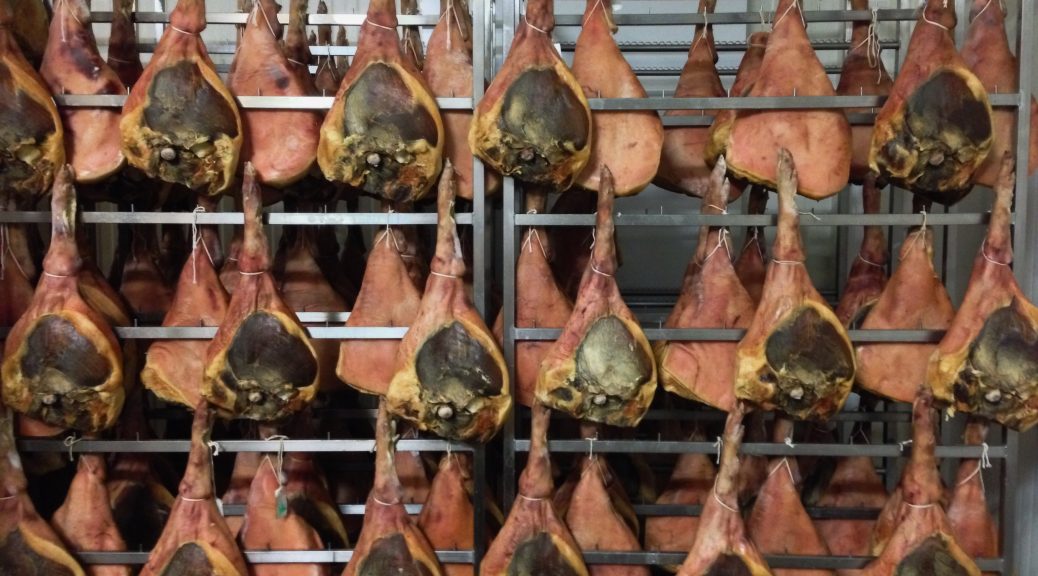It sounds basic but I’ll just get it out of the way first: cured meat isn’t cooked. Curing was one of the key discoveries our species hit upon to make meat last for a long time at ambient temperatures and not get us sick. Curing is what differentiates a sausage (uncured) from a salami (cured).
Curing works its magic by eliminating bad bacteria from meat in two ways.
First, by drying. Bacteria need moisture to grow. Curing deprives them of it, usually with a combination of salt and some environmental measures, like dehumidified aging rooms.
Second, by fermentation. Fermentation makes a salami acidic, which kills the bacteria. Not every cured meat is fermented—cured hams aren’t, for example—but they’re all dried. Once the process is complete, cured meat is safe from the bacteria that would spoil it. That means it can be stored at room temperature for a long time, until we’re ready to eat it.
“Cured” is a legal term, too.
In the U.S., “cured” is not just a word to describe salami, ham or bacon. It’s also a regulatory label enforced by the USDA. To count as cured in their eyes you have to use nitrates from specific sources. Salt and saltpeter count. Celery, beet, and spinach—all naturally occurring sources of nitrates—don’t, which is why you’ll often see the oxymoron “uncured bacon” on some labels. Let me assure you: uncured bacon is cured. You can’t make bacon without curing it. Uncured bacon would just be called pork belly.
Why does this have to be so confusing? Frankly, I have no idea. The science is pretty straightforward. Plus we’ve been doing it right for centuries, since long before we understood the science. We use nitrates and/or salt to prevent botulism and preserve color and flavor. They create an inhospitable environment for the bad bacteria that hurt us but retain a decent environment for the flora that finesse flavor. The meat curer’s job is to manage that balance.
Fast and sour or slow and sweet?
Like with most foods there are ways to do things fast and cheap and there are ways to spend more time and money. Curing is no exception. You can cure a salami quickly in a way that makes it safe but doesn’t make it taste great. On the technical side it often means pushing the pH very low very fast and leaving it there. Lower pH is more acidic, it makes a safe salami. It also makes it sour. If you taste a salami that has a lot of tang chances are the maker went for a fast, cheap cure. To go for a sweeter cure with a higher pH takes more time and care.
A sweet and slow cure is the style of salami Italians pursue and, because the USDA doesn’t let us import a single stick of real Italian salami, for the best version stateside you’ve got to taste around. For my money, Mike Phillips at Minneapolis’s Red Table Meat Co. turns out some of the best Italian style salamis I’ve ever had. (That includes the ones I’ve had in Italy.)
If it’s sweet and slow cured ham you’re after you’ve got a couple more options. For Italian style, my go-to is Herb and Kathy Eckhouse’s midwest ham emporium, La Quercia, from Norwalk, Iowa. I’d choose their ham over imported Italian Prosciutto di Parma any day. There’s also imported Spanish Ibérico de Bellota, which even a proud domestic ham man like Herb refers to as “definitely the world standard.”
Recipe tips from Herb and Mike
The Jewish Ham Sandwich
From Herb & Kathy Eckhouse, founders of La Quercia
“What else would a Jewish ham curer make?” – Herb
Abundantly butter two slices of fresh challah bread with cool, unsalted butter and, between them, lay a couple ounces of room temperature Prosciutto Americano.
Mike’s Salami Tips
From Mike Phillips, founder and chief salami maker at Red Table Meat Co.
Salami should not be old, dry, and cut thin. It should be young and fresh, when the smell is incredible, warm and super floral. The color of salami when you slice it should be pinkish, not deep dark red. I like to cut my salami in half inch cubes. I throw it into everything—if I make a ragu, I toss diced up salami ends in the bolognese. Mushroom ragu too. On pizza diced up—not discs, but little bits that are easier to eat.

